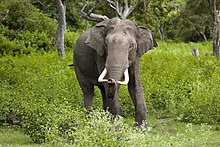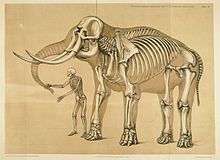วงศ์ช้าง
| วงศ์ช้าง ช่วงเวลาที่มีชีวิตอยู่: Late Miocene–Holocene | |
|---|---|

| |
| ช้างเอเชียเพศผู้ (Elephas maximus) ในป่าที่อุทยานแห่งชาติ Bandipur ประเทศอินเดีย | |
| การจำแนกชั้นทางวิทยาศาสตร์ | |
| โดเมน: | ยูแคริโอต Eukaryota |
| อาณาจักร: | สัตว์ Animalia |
| ไฟลัม: | สัตว์มีแกนสันหลัง Chordata |
| ชั้น: | สัตว์เลี้ยงลูกด้วยนม Mammalia |
| อันดับ: | อันดับช้าง Proboscidea |
| วงศ์ใหญ่: | Elephantoidea Elephantoidea |
| วงศ์: | วงศ์ช้าง Elephantidae Gray, 1821 |
| สกุลต้นแบบ | |
| Elephas Linnaeus, 1758 | |
| สกุล[3] | |
| |
| ชื่อพ้อง[4] | |
| |
วงศ์ช้าง (ชื่อวิทยาศาสตร์: Elephantidae) เป็นวงศ์ตามการอนุกรมวิธาน ได้แก่สัตว์จำพวกช้าง คือ ช้างและแมมมอธ เป็นสัตว์บกเลี้ยงลูกด้วยน้ำนมขนาดใหญ่ที่มีงวงและงา สกุลและชนิดส่วนใหญ่ในวงศ์นี้ได้สูญพันธุ์ไปแล้ว เหลือเพียงสองสกุลเท่านั้นที่ยังมีชีวิตอยู่ ได้แก่ Loxodonta (ช้างแอฟริกา) และ Elephas (ช้างเอเชีย) เท่านั้น
วงศ์ดังกล่าวได้รับการตั้งชื่อโดยจอห์น เอ็ดเวิร์ด เกรย์ใน ค.ศ. 1821[5] และภายหลังถูกจัดเข้าสู่การจำแนกชั้นทางวิทยาศาสตร์ในอันดับ วงศ์ช้างได้ถูกทบทวนโดยนักอนุกรมวิธานหลายคนว่าจะนับรวมสกุลบรรพบุรุษของสัตว์มีงวงอื่นที่สูญพันธุ์ไปแล้วหรือไม่
การจำแนก
[แก้]


นักเขียนบางคยเสนอแนะให้จัดวงศ์นี้ออกเป็น 2 วงศ์ย่อย คือ Stegotetrabelodontinae ที่มีเพียงเฉพาะ Stegotetrabelodon และ Elephantinae ที่มีสัตว์วงศ์ช้างชนิดอื่น ๆ ทั้งหมด[6] การวิจัยทางพันธุกรรมล่าสุดแสดงให้เห็นว่า Elephas กับ Mammuthus มีความใกล้ชิดกันมากกว่า Loxodonta โดย Palaeoloxodon มีความใกล้ชิดกับ Loxodonta มากที่สุด Palaeoloxodon ก็ดูเหมือนว่าจะได้รับการผสมพันธุ์อย่างกว้างขวางระหว่างช้างป่าแอฟริกากับแมมมอธเพียงเล็กน้อย[7]
- Elephantidae
- Loxodonta (แอฟริกา)
- L. africana ช้างพุ่มไม้แอฟริกา
- L. cyclotis ช้างป่าแอฟริกา
- Elephas (เอเชีย)
- E. maximus ช้างเอเชีย
- E. m. maximus ช้างศรีลังกา
- E. m. indicus ช้างอินเดีย
- E. m. sumatranus ช้างสุมาตรา
- E. m. borneensis ช้างบอร์เนียว
- E. maximus ช้างเอเชีย
- Loxodonta (แอฟริกา)
ชนิดที่สุญพันธุ์
[แก้]- Elephantidae
- †Stegotetrabelodon
- S. syrticus
- S. orbus
- S. lybicus
- S. emiratus
- วงศ์ย่อย Elephantinae
- †Primelephas
- P. gomphotheroides
- P. korotorensis
- Elephas
- †Stegoloxodon
- S. celebensis
- S. indonesicus
- Loxodonta
- †Palaeoloxodon
- P. recki
- P. antiquus
- P. namadicus
- P. naumanni
- P. creutzburgi
- P. xylophagou
- P. iolensis
- P. cypriotes
- P. lomolinoi
- P. tiliensis
- P. mnaidriensis
- P. falconeri
- †Mammuthus
- M. africanavus
- M. columbi
- M. creticus
- M. exilis
- M. lamarmorai
- M. meridionalis
- M. primigenius
- M. rumanus
- M. subplanifrons
- M. trogontherii
- น่าจะ †Stegodibelodon
- St. schneideri
- †Primelephas
- †Stegotetrabelodon
ประวัติวิวัฒนาการ
[แก้]
Elephantids คาดว่าวิวัฒนาการจาก gomphothere โดยนักเขียนบางคนเสนอว่าบรรพบุรุษที่มีความเป็นไปได้มากที่สุดคือ Tetralophodon "tetralophodont gomphothere" ชนิดในแอฟริกา[8] สมาชิกแรกสุดของวงศ์นี้มาจากสมัยไมโอซีนตอนปลายเมื่อประมาณ 9–10 ล้านปีก่อน[9] สกุลช้างสมัยใหม่และแมมมอธแยกจากกันในช่วงท้ายของสมัยไมโอซีน Elephantids เริ่มอพยพออกจากแอฟริกาในสมัยไพลโอซีน โดยแมมมอธกับ Elephas เดินทางถึงยูเรเชียประมาณ 3–3.8 ล้านปีก่อน[10] จากนั้น แมมอธอพยพไปยังอเมริกาเหนือเมื่อประมาณ 1.5 ล้านปีก่อน[11] เมื่อถึงช่วงสิ้นสุดของสมัยไพลสโตซีนตอนต้นประมาณ 0.8 ล้านปีก่อน Palaeoloxodon จึงอพยพออกนอกแอฟริกา แล้วแพร่กระจายทั่วยูเรเชีย[12] Palaeoloxodon และ Mammuthus สูญพันธ์ุในสมัยไพลสโตซีนตอนปลาย-สมัยโฮโลซีน โดยประชากรแมมมอธกลุ่มสุดท้ายยังคงอยู่บนเกาะแรงเกลจนกระทั่งประมาณ 4,000 ปีก่อน[13]
อ้างอิง
[แก้]- ↑ H. T. Mackaye, M. Brunet, and P. Tassy. 2005. Selenetherium kolleensis nov. gen. nov. sp.: un nouveau Proboscidea (Mammalia) dans le Pliocène tchadien. Geobios 38(6):765-777
- ↑ Kalb, J. E.; & Froehlich, D. J. (1995). "Interrelationships of Late Neogene Elephantoids: New evidence from the Middle Awash Valley, Afar, Ethiopia". Geobios. 28 (6): 727–736. Bibcode:1995Geobi..28..727K. doi:10.1016/s0016-6995(95)80068-9.
- ↑ Shoshani, J.; Ferretti, M.P.; Lister, A.M.; Agenbroad, L.D.; Saegusa, H.; Mol, D.; Takahashi, K. (2007). "Relationships within the Elephantinae using hyoid characters". Quaternary International. 169–170: 174–185. Bibcode:2007QuInt.169..174S. doi:10.1016/j.quaint.2007.02.003.
- ↑ Maglio, Vincent J. (1973). "Origin and Evolution of the Elephantidae". Transactions of the American Philosophical Society. 63 (3): 16. doi:10.2307/1006229. JSTOR 1006229.
- ↑ Gray, John Edward (1821). "On the natural arrangement of vertebrose animals". London Medical Repository. 15: 297–310.
- ↑ Athanassiou, Athanassios (2022), Vlachos, Evangelos (บ.ก.), "The Fossil Record of Continental Elephants and Mammoths (Mammalia: Proboscidea: Elephantidae) in Greece", Fossil Vertebrates of Greece Vol. 1 (ภาษาอังกฤษ), Cham: Springer International Publishing, pp. 345–391, doi:10.1007/978-3-030-68398-6_13, ISBN 978-3-030-68397-9, S2CID 245067102, สืบค้นเมื่อ 2023-11-21
- ↑ Palkopoulou, Eleftheria; Lipson, Mark; Mallick, Swapan; Nielsen, Svend; Rohland, Nadin; Baleka, Sina; Karpinski, Emil; Ivancevic, Atma M.; To, Thu-Hien; Kortschak, R. Daniel; Raison, Joy M. (2018-03-13). "A comprehensive genomic history of extinct and living elephants". Proceedings of the National Academy of Sciences (ภาษาอังกฤษ). 115 (11): E2566–E2574. Bibcode:2018PNAS..115E2566P. doi:10.1073/pnas.1720554115. ISSN 0027-8424. PMC 5856550. PMID 29483247.
- ↑ Geraads, Denis; Zouhri, Samir; Markov, Georgi N. (2019-05-04). "The first Tetralophodon (Mammalia, Proboscidea) cranium from Africa". Journal of Vertebrate Paleontology (ภาษาอังกฤษ). 39 (3): e1632321. Bibcode:2019JVPal..39E2321G. doi:10.1080/02724634.2019.1632321. ISSN 0272-4634. S2CID 202024016.
- ↑ H. Saegusa, H. Nakaya, Y. Kunimatsu, M. Nakatsukasa, H. Tsujikawa, Y. Sawada, M. Saneyoshi, T. Sakai Earliest elephantid remains from the late Miocene locality, Nakali, Kenya Scientific Annals, School of Geology, Aristotle University of Thessaloniki, Greece VIth International Conference on Mammoths and Their Relatives, vol. 102, Grevena -Siatista, special volume (2014), p. 175
- ↑ Iannucci, Alessio; Sardella, Raffaele (March 2023). "What Does the "Elephant-Equus" Event Mean Today? Reflections on Mammal Dispersal Events around the Pliocene-Pleistocene Boundary and the Flexible Ambiguity of Biochronology". Quaternary (ภาษาอังกฤษ). 6 (1): 16. doi:10.3390/quat6010016. ISSN 2571-550X.
- ↑ Lister, A. M.; Sher, A. V. (November 13, 2015). "Evolution and dispersal of mammoths across the Northern Hemisphere". Science. 350 (6262): 805–809. Bibcode:2015Sci...350..805L. doi:10.1126/science.aac5660. PMID 26564853. S2CID 206639522.
- ↑ Lister, Adrian M. (2004), "Ecological Interactions of Elephantids in Pleistocene Eurasia", Human Paleoecology in the Levantine Corridor, Oxbow Books, pp. 53–60, ISBN 978-1-78570-965-4, สืบค้นเมื่อ 2020-04-14
- ↑ Arppe, Laura; Karhu, Juha A.; Vartanyan, Sergey; Drucker, Dorothée G.; Etu-Sihvola, Heli; Bocherens, Hervé (October 2019). "Thriving or surviving? The isotopic record of the Wrangel Island woolly mammoth population". Quaternary Science Reviews (ภาษาอังกฤษ). 222: 105884. Bibcode:2019QSRv..22205884A. doi:10.1016/j.quascirev.2019.105884. hdl:10138/309133. S2CID 203103403.
แหล่งข้อมูลอื่น
[แก้] วิกิมีเดียคอมมอนส์มีสื่อเกี่ยวกับ Elephantidae
วิกิมีเดียคอมมอนส์มีสื่อเกี่ยวกับ Elephantidae ข้อมูลที่เกี่ยวข้องกับ วงศ์ช้าง ที่วิกิสปีชีส์
ข้อมูลที่เกี่ยวข้องกับ วงศ์ช้าง ที่วิกิสปีชีส์
